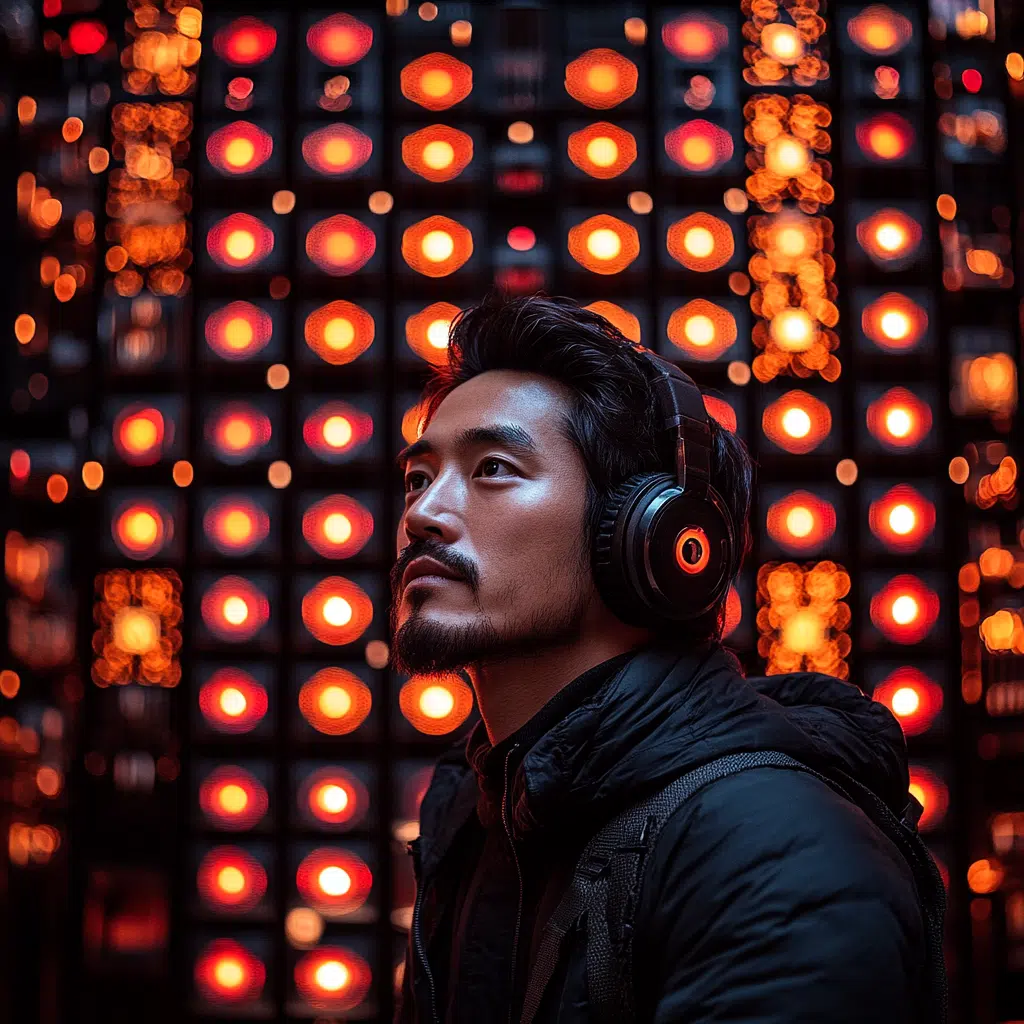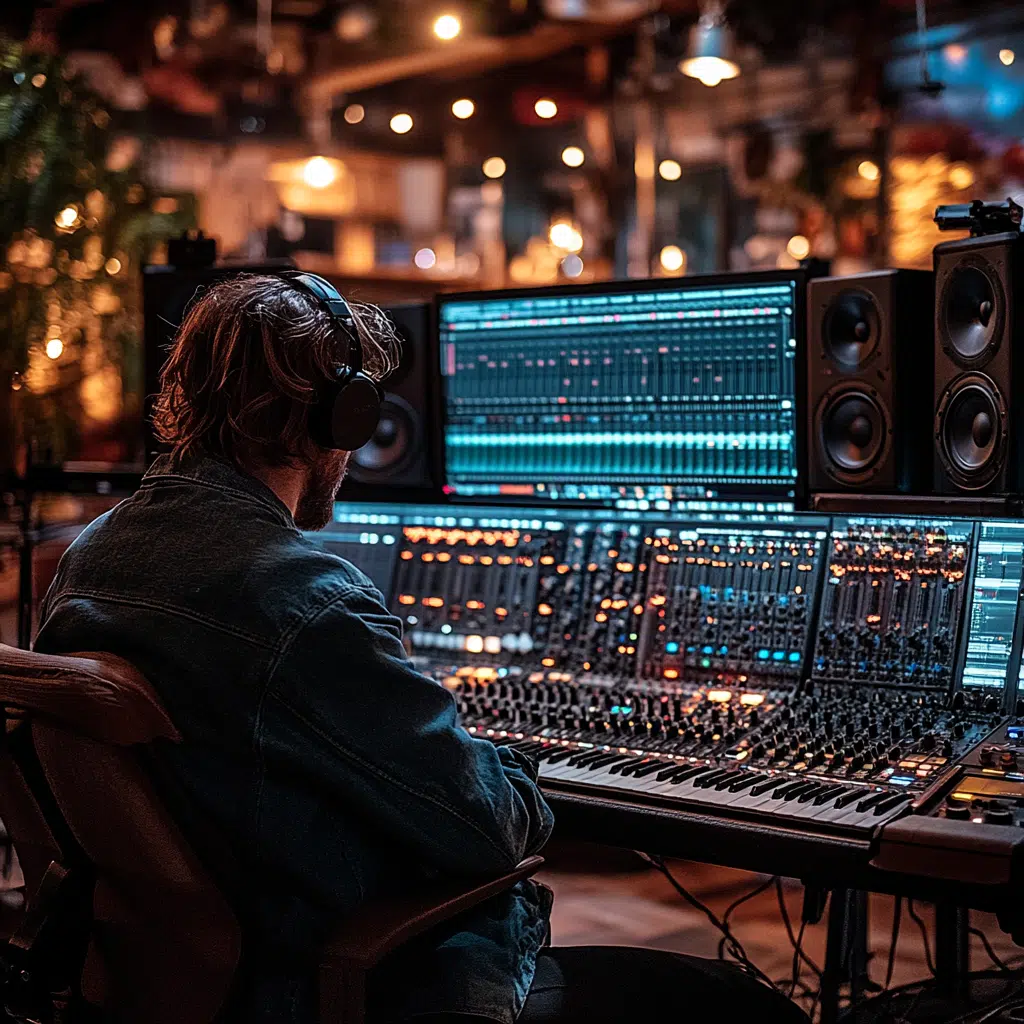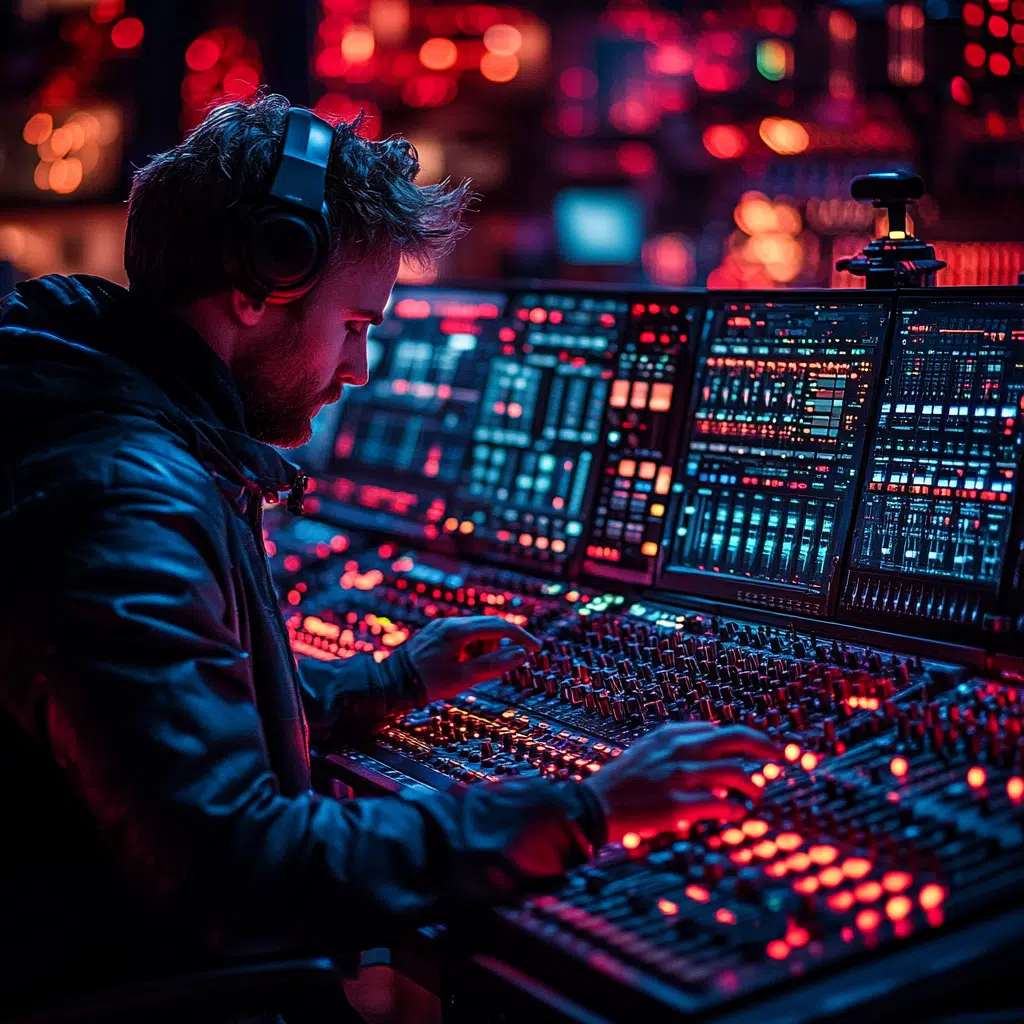Hey there, sound maestros and audio enthusiasts! Welcome to an auditory exploration where we’re diving headfirst into Dolby Atmos Surround Sound Mixing. If you’re itching to elevate your audio game and captivate your audience with unprecedented soundscapes, you’ve landed on the right page. In this guide, we’ll explore how Dolby Atmos revolutionizes immersive sound experiences. Harnessing its potential can turn even a modest sound into a storytelling pillar, creating auditory narratives that leave audiences spellbound.
From the dawn of its innovation in 2012, Dolby Atmos has significantly transformed audio post-production by enabling sound designers and composers to architect rich, three-dimensional sonic worlds. Whether you’re crafting the suspense in a scene or accentuating a character’s journey, Atmos adds unparalleled depth and realism. So, let’s embark on this journey, blending the creative genius of Hans Zimmer with the precision found at Skywalker Sound, offering filmmakers and producers actionable insights that are bound to resonate.
Exploring the Evolution of Dolby Atmos in Sound Mixing
It all kicked off in 2012 when Dolby Atmos first breathed new life into cinema audio. Allowing sound to travel beyond the constraints of channels, Atmos creates a multi-dimensional sound experience. Sound is not just all around you; it’s above you, below you, and everywhere in between.
Filmmakers like Christopher Nolan and Greta Gerwig have tapped into Atmos’s potential, with hits like “Tenet” unraveling within a vortex of intriguing auditory layers, and “Barbie” using sound to colorfully enhance its bubbly visuals. These pioneers have shown that Atmos is not a whimsical accessory but a cornerstone for producing high-impact cinema. As Atmos’s presence bleeds into mainstream production, understanding its evolution provides crucial insights into sound design’s futuristic frontier, akin to dissecting the rise of the microchip in computing.
The Core Principles of Dolby Atmos Surround Sound Mixing
To truly crack the code of Atmos, it’s vital to grasp its core principles, starting with the concept of object-based audio. Blissfully liberated from traditional audio channels, Atmos provides the liberty to treat each sound as an independent object – imagine the precise positioning in a 3D space that brings your soundscape to life. In this visible yet invisible arena, you’re Leonardo sculpting sound with every stroke.
Sound mixers and editors, like Erik Aadahl – renowned for his work on “A Quiet Place”, take advantage of Atmos’s ability to dissect and place sounds dynamically within a scene. From the nuances of whispers to the crescendo of a symphony, Atmos enables you to weave sound into the fabric of your narrative with the brilliance of a seasoned craftsman assembling a bespoke watch.
| Category | Description |
|---|---|
| *Concept* | Dolby Atmos is an immersive audio format that allows sound placement and movement in three dimensions. |
| *Capabilities* | Enables up to 128 distinct sound objects in a mix, providing precision, space, and creative freedom. |
| *Recommended Setup* | A 5.1.4 speaker configuration: five speakers at ear level, one subwoofer, and four overhead speakers. |
| *DAW Integration* | Compatible with leading DAWs like Avid Pro Tools, Apple Logic Pro, Ableton Live, and Steinberg Nuendo. |
| *Main Tools* | Dolby Atmos Music Panner available as AU, AAX, and VST 3 plug-ins for sound positioning in a 3D space. |
| *Master Track Creation* | Essential to create a Dolby Atmos master track as the output in your DAW before building your mix. |
| *Sound Object Routing* | Requires separate audio tracks or buses for each sound object to situate within the Dolby Atmos space. |
| *Platform Support* | Compatible primarily on Apple Mac systems for Dolby Atmos music production and sound design. |
| *Applications* | Ideal for film, TV, and multimedia projects; enhances storytelling through immersive audio experiences. |
| *Benefits* | Offers an expanded audio palette, allowing for detailed spatial soundscapes and enhanced listener engagement. |
Equipment Essentials for Dolby Atmos Mixing: Setting Up the Perfect Studio
Creating an Atmos-compatible studio isn’t about dropping a fortune on gear but investing wisely. A pivotal component is a well-equipped 5.1.4 layout, comprising five speakers, one subwoofer, and four overhead speakers for celestial sound emulation.
Brands like Avid with their S6 control surface, and Yamaha, offering high-fidelity monitoring systems, are your allies. This technical marvel complements the prowess of software giants like Pro Tools, which seamlessly integrates Dolby Atmos functionalities. The gear formulates the backbone of your sonic canvas; from here, your orchestrations can roam the sound spectrum freely. Every film soundscape you’ll create hinges not only on these physical tools but on understanding how to harness their potential effectively.
Techniques for Captivating Dolby Atmos Sound Design
Unveiling the secret recipe for mesmerizing sound design lies in an understanding of vertical sound movement and spatialization – pillars of Atmos’s immersive landscape. At Skywalker Sound, Leslie Ann Jones pushes the boundaries by using space as her ally, crafting soundscapes that are as expansive as the Pacific.
Key techniques involve multi-layering sounds, precise panning, and dynamic spatial effects that breathe life into the visuals. By adopting minute precision akin to a maestro on a podium, every note is directed to traverse the sonic plane, enhancing the narrative. Your role? To be the storyteller who paints emotion with invisible brushes.
In-Depth Case Studies: Successful Dolby Atmos Mixes
The magic of Atmos is best witnessed in films like “Dune” by Denis Villeneuve and Alfonso Cuarón’s “Gravity”. These cases are textbooks of creativity and technical prowess where dialogue, effects, and score meld into one seamless composition.
“Dune” awakened the sand dunes with reverberations that transcend the ordinary, giving audiences an experience rather than a mere viewing. Meanwhile, “Gravity” precisely primed the haunting silence of space, elevating tension through spatial sound. Studying these works reveals not only what Atmos can achieve but the imaginative routes storytellers can traverse.
Overcoming Common Challenges in Dolby Atmos Mixing
Even for the seasoned pro, challenges lurk within Atmos mixing. Sound mixers navigate the waters of managing headroom and dynamically mastering tracks with precision.
Anna Behlmer, a luminary among mixers, speaks on tackling these common hurdles by maintaining audio clarity and protecting listeners from fatigue. Her advice is straightforward: balance is the key. Diverse elements – be it dialogue, sound effects, or music – must coexist harmoniously within the lattice of an Atmos mix.
Future Trends in Dolby Atmos Sound Design
Atmos’s journey does not stall at film alone. Its voyage sails towards integration with virtual reality (VR) and interactive media, painting it as a cornerstone in modern sound design.
Big names like Valve and Oculus lead the charge, exploring new immersion levels in gaming. These trends shed light on how Atmos continues to reshape not just solitary viewing experiences but communal and interactive ventures, forcing a rethink of traditional entertainment boundaries.
The Art of Composing Original Music for Dolby Atmos
Composing music for Atmos is akin to sculpting a symphony in the round—a creative adventure that musicians like Hans Zimmer embark upon. The multidirectional capabilities of Atmos allow scores to envelop audiences, crafting an emotional resonance that transcends mere sound.
In “Interstellar”, Zimmer’s work exemplifies the intertwining of spatial orchestration with narrative ambitions. Utilizing Atmos’s canvas, musicians can map their compositions according to storyline contours, creating scores that don’t just accompany but narrate in their right.
Enhancing Multimedia Projects with Dolby Atmos Technology
Dolby Atmos isn’t confined to film; it’s a chameleon, adapting into diverse multimedia forms. Take Janet Cardiff’s audio walks – here, city sounds morph into vibrant tapestries, accentuated through Atmos, reengaging with the environment in dramatic ways.
Art installations and theatre productions utilize Atmos to add new dimensions to narratives. Each project serves to illustrate the technological flexibility of Atmos, reaffirming its place not just in sound design, but as an inspiration across creative disciplines.
Reflecting on the Journey of Dolby Atmos Excellence
As we wrap up, it’s clear that Dolby Atmos has profoundly impacted the way we experience sound. It elevates storytelling into an auditory journey that resonates with audiences on a personal level, echoing the depths of emotion and narrative complexity.
The transformation Atmos represents is apt for today’s fast-paced media landscape, aligning with expectations for innovation and immersion. It proves, unequivocally, that in sound design, as in storytelling, the possibilities are truly as limitless as your imagination.
In the ever-growing auditory domain, Atmos stands as a beacon, not just redefining expectations but crafting the future of sound. Whether it’s remote sound mixing from New York or discovering the future trends in sound design, aligning with Atmos won’t just set you apart; it’ll propel you into a future where sound is an embrace that audiences willingly succumb to.🔥
Dolby Atmos Surround Sound Mixing: Unveiling the Sonic Frontier
Delving into Dolby Atmos Surround Sound Mixing is like peeling back the layers of an auditory onion; there’s more depth and flavor than you’d expect. This cutting-edge technology offers film and TV creators a three-dimensional sound experience that’s, frankly, out of this world. Imagine the subtle trickle of rain from a scene in Slaughter Beach, where every droplet seems to fall from above and around you, making the audience feel truly immersed. With Dolby Atmos, audio is no longer just left, right, or center; it’s everywhere you can imagine.
Mixing Mastery
To craft this spatial soundscape, mixing engineers dive into tools that let them place audio elements in a virtual three-dimensional space. It’s akin to a Call Of The Night Season 2 episode where sounds move around you like shades in the night. This wizardry is evolved with the times, with engineers often working from diverse locations like those specializing in Remote Sound mixing new york. It’s a task that might seem as intricate as explaining a co signer meaning to a novice, yet for professionals, it’s an exciting challenge, a mix of art and precision. This technology isn’t just a cherry on top; it transforms how we experience narratives.
Sound Editing like Only Pros Can
Editing for Dolby Atmos isn’t your average cut-and-dry job. It’s a creative dance where each sound is meticulously positioned to optimize the viewer’s experience. Thanks to specialized services across the globe, like those offering Remote Audio post Production Canada, editors can sculpt soundscapes that elevate storytelling to new heights. Whether it’s the rustle of leaves or the distant echoes of a storm, every element counts. Just like exploring the peculiar concept of a Targeta Roja, every sound detail could be the winning move in crafting a standout project.
So, there you have it: a glimpse into the electrifying domain of Dolby Atmos Surround Sound Mixing. From Remote Sound editing Services that string every note and nuance into place, to mastering equipment that might have you pondering historical arm rates today, this tech is about creating sound you can almost touch. Whether you’re an audio novice or a seasoned creator, Dolby Atmos is the key to unlocking new dimensions in storytelling. Ready to turn it up a notch?
Is Dolby Atmos good for mixing?
Dolby Atmos is fantastic for mixing because it lets you create a rich, immersive sound experience by placing and moving audio in three-dimensional space. This flexibility means you can deliver a mix that feels like it’s happening all around the listener, enhancing the overall impact of your project.
How to mix on Dolby Atmos?
To mix on Dolby Atmos, start by creating a Dolby Atmos master track in your digital audio workstation (DAW). Then, make sure to set up audio tracks or buses for each sound object you want to position in the 3D space. You can use up to 128 different sound objects in your Atmos mix, offering a lot of creative freedom.
How many speakers do I need for Dolby Atmos mixing?
For Dolby Atmos mixing, aim for a 5.1.4 speaker layout. This setup consists of five speakers at ear level, one subwoofer for the low-end frequencies, and four overhead speakers to capture those height elements that really make the audio come alive.
What software is used to mix Dolby Atmos?
When mixing Dolby Atmos, you can choose from a range of industry-standard software. The Dolby Atmos Music Panner plug-in is available in AU, AAX, and VST 3 formats and works seamlessly with top DAWs like Avid Pro Tools, Apple Logic Pro, Ableton Live, and Steinberg Nuendo on Apple Mac systems.
What is the disadvantage of Dolby Atmos?
One downside of Dolby Atmos can be the cost and complexity of setting up the ideal speaker arrangement and processing environment. It also demands a learning curve to effectively use the expanded capabilities and ensure that your project actually benefits from the immersive audio experience.
What speaker placement for Dolby Atmos mixing?
Dolby Atmos speaker placement involves setting up a 5.1.4 system. This includes five speakers around ear level, one subwoofer, and four overhead speakers. Proper placement is crucial to fully engage the three-dimensional sound design that Dolby Atmos provides.
How do I get the best sound on my Dolby Atmos?
For the best sound in Dolby Atmos, ensure you have a properly calibrated 5.1.4 speaker setup and optimize the room acoustics to minimize sound reflections. Always test and adjust your mix by listening from various points in the room to ensure consistency across the intended listening area.
What is the minimum room size for Dolby Atmos mixing?
There isn’t a strict minimum room size for Dolby Atmos mixing, but generally, you’ll want a space large enough to accommodate a 5.1.4 speaker setup with enough room for sound to travel effectively. A bigger room with good acoustics will typically yield better results.
What is the best audio connection for Dolby Atmos?
The best audio connection for Dolby Atmos is generally HDMI, as it can carry the required bandwidth for multiple channels of high-quality audio. Make sure your audio interface and playback system support the formats you’re using for Dolby Atmos content.
How much does Dolby Atmos mixing cost?
The cost of Dolby Atmos mixing varies widely depending on the scale of the project and the studio setup. Expect higher prices than traditional stereo or 5.1 mixing due to the need for specialized equipment, software, and the expertise required to create the desired immersive experience.
How high should speakers be for Dolby Atmos setup?
Speakers for a Dolby Atmos setup should ideally be positioned at ear level for the horizontal array, while the overhead speakers should be mounted high enough to effectively cover the listening area, often recommended between 8 to 10 feet off the ground.
Do Atmos mixes get mastered?
Yes, Atmos mixes do get mastered. Mastering in Dolby Atmos ensures the final mix is balanced and polished across all channels, maintaining the integrity of the immersive audio experience when played back on various devices and listening environments.
Can you mix in Dolby Atmos?
You can definitely mix in Dolby Atmos if you have the right setup, which includes a DAW capable of handling Atmos, such as Pro Tools or Logic Pro, and a proper 3D speaker layout. It allows you to creatively position sounds around the listener for an immersive experience.
What are the standards for Dolby Atmos mixing?
Standards for Dolby Atmos mixing include using a compatible DAW, adhering to Dolby’s recommended speaker configurations, and ensuring that sound objects and bed mixes are accurately placed and balanced to create a compelling 3D audio environment.
How do I distribute Dolby Atmos?
To distribute Dolby Atmos, you can use platforms and services that support it, such as streaming services like Netflix or Apple Music. Ensure your files are properly encoded and formatted to meet the requirements of the distribution platform.
Does Dolby Atmos make sound better?
Dolby Atmos can indeed make sound better by providing a more immersive and engaging listening experience. By expanding sound beyond traditional stereo channels into a three-dimensional space, it gives audiences a sense of presence and reality that traditional setups can’t match.
Do Atmos mixes get mastered?
Atmos mixes are indeed mastered to ensure they translate well across different playback systems and environments. Mastering helps balance the audio levels, make sure the dynamic range is suitable, and enhance the overall quality of the final product.
Does Dolby Atmos make any difference?
Yes, Dolby Atmos can make a noticeable difference, particularly in enhancing the depth and space of audio. It plays sounds around and above you, which can significantly elevate the storytelling and emotional impact of films, games, and music projects.
What are the standards for Dolby Atmos mixing?
Standards for Dolby Atmos mixing involve using compatible production tools and maintaining adherence to recommended speaker layouts like 5.1.4. Proper training and experience are essential to producing a balanced mix that fully leverages the enhanced spatial capabilities of Atmos systems.



